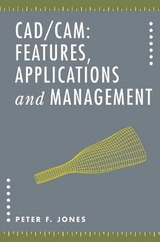
CAD/CAM
Features, Applications and Management
Seiten
1992
Palgrave Macmillan (Verlag)
978-0-333-48531-6 (ISBN)
Palgrave Macmillan (Verlag)
978-0-333-48531-6 (ISBN)
- Titel erscheint in neuer Auflage
- Artikel merken
Zu diesem Artikel existiert eine Nachauflage
Computer aided manufacturing (CAM) is examined in a practical way in this book. It is assumed that the reader will be concerned with a commercially available CAD/CAM system, intended for use by designers. This book examines the use of the CAD system and its commercial applications.
Computer aided manufacturing (CAM) is examined in a practical way in this book by Peter Jones. It is assumed that the reader will be concerned with a commercially available CAD/CAM system, intended for use by designers. Such a system often provides facilities for the geometry defined by the designer to be converted into control instructions for numerically controlled machine tools. This process is described and its relationship with manufacturing procedures is discussed but the detail of part programming machine tools is not covered on the grounds that it is usually the concern of manufacturing specialists. Designers need to know their CAD models may be used to supply data to manufacturing but they will not normally be involved in actual programming of the machine tools. This book begins with an account of the way computers do their job for the benefit of older engineers who may not have had the opportunity of understanding the basics of digital computers. The following chapters explain the advantages and pitfalls of using CAD, as well as a discussion of the various types of equipment to be found in a CAD installation.
The final section includes a presentation of the functions of CAD software. The book is designed to provide a technical background to evaluating and procuring a CAD/CAM system.
Computer aided manufacturing (CAM) is examined in a practical way in this book by Peter Jones. It is assumed that the reader will be concerned with a commercially available CAD/CAM system, intended for use by designers. Such a system often provides facilities for the geometry defined by the designer to be converted into control instructions for numerically controlled machine tools. This process is described and its relationship with manufacturing procedures is discussed but the detail of part programming machine tools is not covered on the grounds that it is usually the concern of manufacturing specialists. Designers need to know their CAD models may be used to supply data to manufacturing but they will not normally be involved in actual programming of the machine tools. This book begins with an account of the way computers do their job for the benefit of older engineers who may not have had the opportunity of understanding the basics of digital computers. The following chapters explain the advantages and pitfalls of using CAD, as well as a discussion of the various types of equipment to be found in a CAD installation.
The final section includes a presentation of the functions of CAD software. The book is designed to provide a technical background to evaluating and procuring a CAD/CAM system.
An introduction to computers; CAD/CAM and its value; hardware; features and facilities; standards; management features; choosing, ordering and installing; running the installation.
| Erscheint lt. Verlag | 21.7.1992 |
|---|---|
| Zusatzinfo | 94ill. |
| Verlagsort | Basingstoke |
| Sprache | englisch |
| Maße | 156 x 234 mm |
| Gewicht | 506 g |
| Themenwelt | Informatik ► Weitere Themen ► CAD-Programme |
| Technik ► Maschinenbau | |
| ISBN-10 | 0-333-48531-9 / 0333485319 |
| ISBN-13 | 978-0-333-48531-6 / 9780333485316 |
| Zustand | Neuware |
| Haben Sie eine Frage zum Produkt? |
Mehr entdecken
aus dem Bereich
aus dem Bereich
Buch | Softcover (2023)
Beuth (Verlag)
CHF 138,60
Einführung in die Geometrische Produktspezifikation
Buch | Softcover (2023)
Europa-Lehrmittel (Verlag)
CHF 27,90



